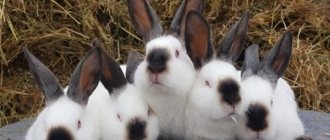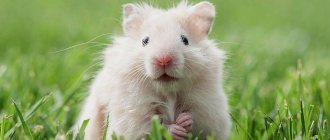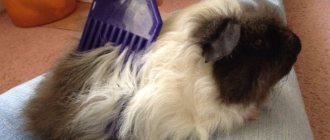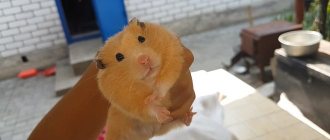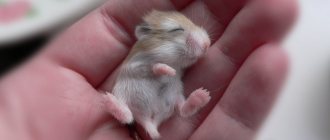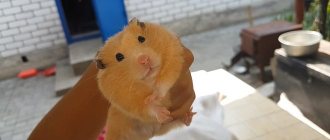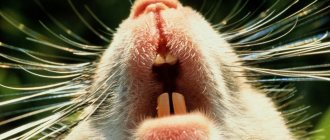07/10/2019 Irina Malinina 0 comments
The Djungarian hamster is a popular animal that can be very often found in modern apartments. This small rodent, belonging to the hamster family, is quite easy to care for. It does not require large material costs and does not require constant attention. At the same time, the funny baby will happily play with the children and amuse them with his antics.
The natural habitat of small rodents is Western Siberia, North-Eastern Kazakhstan, Central and Western Asia.
Origin of Djungarian hamsters
The first mention of the Djungarian breed of hamsters appeared in the works of the German scientist P.S. Pallas in 1773. This researcher described the characteristics of the animal. In the middle of the 19th century. The first successful attempts were made to domesticate these representatives of the fauna. At the beginning of the 20th century. In Europe, keeping rodents at home has become popular, which has contributed to an increase in the population of these animals.
All hamsters currently bred in captivity are descended from a small number of wild-caught individuals.
This contributed to the emergence of mutations, incl. causing coat colors uncharacteristic for the breed. Subsequently, through breeding work, new colors were fixed at the genetic level.
Djungarian hamster - history of origin and domestication
Hamsters became popular pets not so long ago, but very quickly and firmly took their place as favorites. Syrian hamsters were among the first to come into people's homes, but today Djungarians are also of particular interest.
The Djungarian hamster is part of the group of hairy hamsters, which also includes Campbell's hamster and Roborovsky's hamster. All these animals are united by a similar appearance: small size, large head with beady eyes and furry feet that help the animal move along the sand without falling through.
Of all the representatives of the genus, the Djungarian hamster was the first to catch the eye of man. Academician Pallas met him when he went on an expedition to Kazakhstan.
In the 17th and 18th centuries, Dzungaria was the name given to the territory of the Oirat, or otherwise the Dzungarian Khanate, which included Eastern Kazakhstan.
From here it becomes clear why the scientist gave such a name to the found animal.
The Djungarian hamster lives mainly in semi-deserts and dry steppes. Occasionally it can be found on the outskirts of the forest-steppe. The animal lives in burrows that reach a length of 1 meter and have several branches. It feeds on larvae and caterpillars, seeds and the green parts of growing plants. It does not hibernate and is most active at night.
In places where snow falls in winter, by the end of autumn the coat of hamsters becomes almost white.
This suggests that babies often crawl out of their burrows to the surface in winter.
Initially, the rodents were captured and brought to the laboratory for study. There they felt great and multiplied very quickly. Soon they began to be bred purposefully as pets. All the animals we meet now are domesticated representatives of the hamster family, which were previously found only in the wild.
Description of the breed
Djungarian hamsters are small, furry animals with a pointed muzzle and small ears. These creatures are active and inquisitive. Many people try to change their coat color, believing that such animals have better health. However, there are breeders who prefer pets of exotic colors.
Habitat
The homeland of Djungarian hamsters is the wormwood, xerophytic, gravelly-cinquefoil, and cereal-desert zones of North-Eastern Kazakhstan, Khakassia, and Western Siberia. Representatives of the breed also live in Altai. They can rarely be found in the steppe zones of the USA and Canada, but in these regions the wild population originated from pets brought from Europe, which people released into the natural environment.
Wild hamsters living in steppes and deserts are forced to obtain their own food, so their diet includes many types of food.
Rodents try to stay away from people, but when there is a lack of food in their natural environment, they raid agricultural land.
Coat color and length
Under natural conditions, the color of an animal's coat changes throughout the year. In spring and early summer, the fur on the back of the rodent is dark gray. At the same time, the abdomen remains beige. As the vegetation dies by the beginning of autumn, the fur acquires a pearl color.
In winter, the fur on the back becomes grey-white. This breed is characterized by a stripe of dark fur running along the spine and extending to the head. Changing colors helps animals protect themselves from predators. The length of the coat does not exceed 1 cm. There is a dense undercoat that protects the rodent from the cold. When kept at home, the color of the pet's fur does not change.
Color options for Djungarian hamsters.
Length and weight
Djungarians are small rodents whose body length is on average 7-15 cm. However, in the population there are smaller individuals that grow to 5-6 cm by the time of puberty.
The animal does not weigh the same throughout the year. In winter, it quickly loses weight, and in spring and summer it gains fat, even if the rodent lives in captivity and receives a sufficient amount of food every day. The weight of females is 19-36 g, and males - 19-45 g.
Character and lifestyle
In their natural environment, hamsters are nocturnal to avoid predators. Rodents dig holes or occupy others, often making nests in rock crevices. The animals spend most of the day in their shelter. Representatives of the species make provisions for the cold season.
Domesticated animals have largely retained the habits of their wild relatives. They are most active at night and can carry food into their house to stock up in case of a hungry period. These animals fiercely defend their territory. The fights between them are fierce.
The rodent is distinguished by its friendliness towards humans. The animal quickly gets used to its owner and begins to respond to its name. Loves stroking. You can accustom the animal to regular combing of its fur. Some pets fall asleep easily in your arms.
Djungarians love to be petted.
Lifespan
In their natural environment, these animals often die at a young age due to lack of food and attacks by predators. In captivity, they live on average about 2-3 years. However, if you provide the rodent with proper care, it can please its owner for 4 years.
Which hamster to choose
Hamsters are often given to children to teach them how to care for a pet and instill in them a sense of responsibility. Also, these small rodents are often chosen as a pet by adults who have little free time. Hamsters are unpretentious, do not require much attention and special care, and are easy to keep at home.
To choose a hamster for a child, the final decision must be made by the parents. Children are more interested only in the appearance of the pet. For parents, something completely different is important: is the hamster aggressive, does it bite, how to keep it, is there a smell in the apartment, how often to clean after it.
But at the same time, it is important to listen and take into account the child’s wishes. He should like the pet, and the child should have a desire to look after and care for it.
What are the main differences between hamsters?:
- Breed.
- Color.
- Wool length.
- Floor.
- Age.
- Behavior.
Before getting a hamster, you should study these differences in more detail. It is also worth paying attention to other equally important points.
The lifespan of hamsters at home is quite short. Depending on the species, these rodents live on average 2-3 years. Therefore, in addition to the type and color, you need to decide on the place where to buy a hamster. If you buy a rodent from your hands or at the market, there is a high chance of getting a sick individual that will not live long. Then all efforts are in vain and such an acquisition will not bring joy and happiness. Let's take a closer look at which hamster is best to get and where to buy it.
Age
One of the most important indicators when choosing a hamster. The older the hamster, the less time it will live with its owner. Also, an adult is more difficult to tame. Adult hamsters take longer to get used to their new place of residence and take a long time to adapt to new conditions.
The optimal age of a hamster is 1-2 months. If you take a hamster that is less than 1 month old, there is a high probability that it will die.
Floor
Before deciding on the breed of hamster, you need to decide what gender to choose for your future pet.
Males and females can be distinguished by their behavior. If several individuals are sitting in one cage, then by looking closely you can accurately determine where the female is and where the male is.
- males are slightly larger in size and have a calm disposition. They often act more affectionate and friendly. It is easier to establish contact with a male;
- females are slightly smaller. They are more active, mobile and playful. They do not sit still, constantly running around the cage or rummaging through the litter.
Only individuals of different sexes can be kept in one cage. Same-sex individuals will quarrel and divide territory. They also do not tolerate hamsters of other species on their territory.
When keeping different-sex individuals, the female will give birth. Such small animals are not sterilized, so the appearance of offspring cannot be avoided. If there are no plans to engage in breeding, then you need to keep one hamster in one cage.
When choosing a male, it is worth noting the disadvantages of keeping it. Firstly, the male has a stronger and more noticeable odor than the female. Secondly, he will mark his territory and his urine will also smell stronger than the female's. Therefore, when keeping males, in order to avoid an unpleasant odor, the cage is cleaned somewhat more often.
Hamster breed
The most popular domestic types of hamsters:
- Syrian;
- Dzungarian;
- Campbell;
- Roborovsky.
Each species has its own individual characteristics. They differ in size, color, behavior and lifespan.
Syrian hamster
The body length is on average 15 cm, some individuals reach 20 cm. Body weight is 100-200 grams. They live on average 2-3 years; many individuals, with good care, can live up to 4 years.
Of all the species, the Syrian hamster is considered the largest. For children 6-8 years old, this type will be the best choice as it is easy to hold. Small species of hamsters are very nimble and can slip out.
Pros of being a Syrian:
- Large, easy to pick up and hold in your hands;
- Live longer than other domestic hamster species;
- Many different colors;
- There are many subspecies that differ in coat length;
- Friendly, do not show aggression;
- They are easy to tame and quickly make contact with humans.
The downside is that they take up more space. Large hamsters require a slightly larger cage than smaller species.
According to the length of their fur, Syrian hamsters are divided into:
- Long-haired;
- Short-haired;
- Hairless.
If you choose a long-haired Syrian, then his coat must be looked after daily. Once a day, use a special brush to comb out tangles and debris from the wool.
Djungarian hamster
Body length 10 cm, weight 50 grams. Djungarian hamsters live on average 1.5-2 years, rarely living up to 3 years.
Djungarians are very small and nimble hamsters. Children who are too young should not choose them, since such small hamsters are difficult to hold in their hands. Djungarians are very shy, they should be tamed immediately, otherwise adults may bite.
You can keep one hamster in one cage; they do not get along well with same-sex relatives. Djungarians are susceptible to diabetes, so their diet must be carefully monitored.
Roborovsky
Body length 5 cm, weight 30 grams. They live on average 1.5-2 years.
One of the advantages of having such a hamster is that this is the only species that gets along well with other individuals in the same cage.
Among the disadvantages of the establishment, these are the smallest hamsters, which are not easy to hold in the hands even of adults. This is also a rare species of hamster that is difficult to find for sale.
Campbell
Body length 8 cm, weight 30 g. Lifespan 2 years.
A very rare species of hamster that is rarely sold in pet stores. Can be found for sale from breeders in nurseries. If you still manage to find such a hamster, you should check that the hamster is tame. Among Campbell's hamsters there are often wild and untamed individuals.
If you choose a hamster for children, then you should pay attention to the largest types of hamsters. Little hamsters are very nimble. It is very difficult for children to hold them in their hands, which is why hamsters often break out of their hands and fall from a height. Such falls often result in injuries and bruises. Also, a hamster can run away, but finding and catching such a baby is quite problematic.
Selection and arrangement of the cage
There are special requirements for the selection and arrangement of the cage.
It should contain:
- "sports" zone;
- feeding area;
- shelters.
Many breeders also recommend installing a “dry” bath inside the cage. Rodents love to rub against sand to clean their fur and remove dead hairs during shedding.
Requirements
Djungarian hamsters are small, but they require a lot of space. The minimum size of the cage bottom is 55x30 cm. However, it is better to have twice as much space. You can buy a two-tier cage with metal bars. The pallet must be plastic or wooden. It is unacceptable to have a mesh on the bottom, because... getting a rodent's claw or finger into the cell will cause injury. It is desirable that the tray be removable.
The hamster cage should be as large as possible, at least 55x30 cm.
In the cage, you must install a resting house made of hay, special labyrinths and holes of different heights and shapes, as well as several snags under which the pet can retire or hide food.
Sports area
The hamster has a fast metabolism, so if the animal does not move a lot, its fat layer will begin to increase. Excess weight is extremely dangerous for the health of these animals.
In natural conditions, rodents travel up to 10 km a day, so it is important to properly set up a sports area in the cage. Hamsters love to run on wheels. Its diameter must be at least 16 cm. It is better if the wheel is solid so that the animal’s paws do not fall between the bars.
Eating area
The arrangement of the eating area also needs to be given special attention. As a feeder, you can use a metal container up to 2 cm deep. It is important that it is heavy enough. In this case, the animal will not be able to turn it over. Hanging plastic feeders are also convenient. They are attached to the bars of the cage, so the rodent will not be able to move them.
If the hamster receives succulent food every day, it is not necessary to install a container of water.
However, when eating dry grains, the animal may feel thirsty. It is better to install a mounted drinking bowl so that the rodent does not turn it over and wet the bedding.
Carrying and necessary accessories
For a hamster, a simple metal or plastic carrier with a length of at least 15 cm will be sufficient. This device is useful when visiting a veterinary clinic. In addition, you can place the animal here while cleaning the cage.
A hamster carrier is an important thing that you can’t do without.
The required minimum of auxiliary accessories includes a walking ball. While wearing it, your pet will be able to safely walk throughout the house. In addition, it is advisable to buy a teeth sharpener made from compressed grass.
Cleaning
Wood pellets or dry grass can be used as bedding. The filler layer should be at least 3 cm. A removable tray will make it easier to keep the cage clean. Every day you need to remove the remains of succulent feed. It is recommended to change the litter once every 2 weeks. Hamsters often only defecate in one corner. Only the contaminated part of the filler should be replaced. Preserved supplies and the smell of the animal remaining on the bedding will help the rodent avoid stress.
Care and maintenance
Cell selection
It is better to keep a dwarf hamster in a non-galvanized cage measuring 30 cm by 50 cm. A small pet loves space. Some owners keep their hamsters in aquariums. This is also possible, but the aquarium must be spacious.
A narrow, small aquarium is poorly ventilated and is a favorable environment for the growth of bacteria.
Experts recommend choosing single-tier cages that will not cause injury to your pet. But nowadays you can also see two-tier cages on sale, equipped in accordance with all safety rules.
A mesh tray should also not be used.
An active baby can injure his paws.
Filling the cell
How and what to fill the cage with so that the cute fluffy feels comfortable in it? First of all, you need to install a feeder and drinker. It is better to use a clay or ceramic bowl as a feeder, heavy enough so that the rodent cannot turn it over.
But it is not recommended to pour water into a bowl; it is better to use a closed drinking bowl. There should always be a chalky or mineral stone in the cage on which the rodent can grind its teeth.
It is recommended to place a house in a corner. There is no need to try to fill it with something, the hamster will handle this matter himself.
Wood shavings, preferably from leaf trees, should be used as bedding. Such shavings do not contain harmful substances and will not cause illness.
Under no circumstances should you cover the bottom of the cage with cotton wool, pieces of torn newspaper or rags. They will definitely become a breeding ground for various diseases and a source of unpleasant odors.
Considering the habit of the dwarf to go to the toilet in a certain corner, you can install a small container there. You can make it yourself or buy it at a pet store.
Photo: https://pixabay.com/photos/hamster-pet-cage-rodent-small-2724476/
If the size of the cage allows, it is necessary to install tunnels, climbing devices and a running wheel.
The wheel is an essential item, since the hamster needs to run more than one kilometer every day to keep itself in excellent shape.
Under natural conditions, these rodents also run a lot, often covering more than one kilometer in order to find food.
To entertain your miniature pet, and yourself at the same time, you can purchase a walking ball. While in the ball, the baby will be able to move around the entire apartment and at the same time will not be able to run away anywhere.
Hygiene
How to care for a hamster and how burdensome is it? First of all, you need to remove remnants of plant food from the cage every day. If this is not done, the thrifty hamster will collect a whole bunch of them, they can turn sour and moldy and cause intestinal upset.
It is recommended to change the bedding once a week, not only in the cage, but also in the house. You also need to wash the cage and all accessories that the rodent uses. A simple sponge and laundry soap will do for this. Periodically, you can treat the cage with special solutions that disinfect.
The hamster will definitely experience stress if he sees that all his supplies from the pantry have disappeared and a radical rearrangement has been made in the cage.
After cleaning, you need to leave a little of the old litter, which retains a familiar smell for the rodent. It's also not worth emptying your pantry completely. Only perishable items should be removed. Otherwise, the pet will constantly look for a new and safe place, trying to save its stash. The animal will be nervous and uncomfortable.
If the pet goes to the toilet, which the owner has specially adapted for this purpose, cleaning up after the baby will be even easier.
To teach a hamster to relieve itself in a kind of tray, you need to put some already contaminated litter or feces there.
The animal will have to be fed every day; clean water must be poured into the drinking bowl every day.
Photo: https://pixabay.com/photos/hamster-pets-small-animals-3528438/
It is better to do this not in the morning, but at the moment when the animal wakes up.
The Djungarian hamster does not need bathing. But it happens that his fur becomes matted and takes on a dull appearance. In this case, you can give him a sand bath. You can pour sand into the container, in which the baby will happily wallow while cleaning his fur coat.
It is better to buy sand at a pet store.
You should not use one that you yourself mined in a nearby sandbox. It may contain parasites and their larvae. If there is a need to use sand from the street, it must first be calcined.
Animal food
The issue of feeding should be approached responsibly. You need to know what hamsters eat in order to properly develop a feeding diet. You can purchase a ready-made vegetable-grain mixture in the store, which can be used as a basis.
Buy only food for dwarfs.
Food for Syrian hamsters, rabbits and guinea pigs is coarser and has a different composition. They will not benefit the small rodent; moreover, they may even harm it.
In addition to grain food, it is recommended to treat your pet with carrots, pears and apples, seeds, seedless berries, and nuts.
Green leaves of fruit trees are a delicacy for rodents. You can also dry twigs from these same trees for future use so that your baby can enjoy them all year round. You can also add starch-free vegetables cooked without salt, porridge, fermented milk products, yogurt without dye, and a boiled egg to your pet’s menu.
A pregnant female and a thin, sickly dwarf must be fed with baby food. It is better to cook it with water, without adding any sugar or salt.
It is strictly forbidden to treat your pet to the following products: citrus fruits, sweets and chocolate, sugar and honey, smoked meats, semi-finished meat products, butter, pine twigs.
If your Djungarian hamster suffers from indigestion, you need to feed it a decoction of rice. If your pet is constipated, you need to give him a drop of vegetable oil.
Food should be put in reserve, so that the rodent can leave some for tomorrow and feel more comfortable.
Reproduction and offspring
Djungarians have no problems with reproduction; their broods are quite numerous.
Photo: https://pixabay.com/photos/hamster-pups-hamster-hamster-puppies-2693007/
The number of babies can reach 11 pieces!
If under natural conditions Djungarian hamsters breed only from March to September, then rodents living at home can do this all year round.
The mother feeds the babies with milk for about 19 days. Her pregnancy lasts from 18 to 22 days.
When hamsters reach one month of age, it is recommended to seat them based on their gender. After all, from 4-6 weeks of age, animals reach sexual maturity and can become parents themselves. For a female, pregnancy at such an early age is undesirable; it can pose a danger to health and life.
24 hours after giving birth, the female is ready to conceive again.
A pregnant hamster needs to be created as comfortable as possible. Stress experienced throughout the entire period of gestation can lead to the mother immediately killing and eating her babies. It is also not recommended to touch newborns. Sensing an unfamiliar smell, the mother will quickly deal with the tiny hamster.
Before giving birth, you need to wash the cage and disinfect it.
Animal health
The most common diseases found in Djungarians are the following:
- conjunctivitis;
- cataract;
- viral diseases;
- dermatophytosis;
- eczema;
- bacterial infections.
Djungarian hamsters have dental problems. Sometimes the incisors break off, or, conversely, become very long and prevent the animal from absorbing food normally. In this case, you will need the help of a qualified specialist.
Also, very often children get injured when falling from a height. A bad fall can result in dislocations and even fractures. Each such fall is necessarily accompanied by shock.
A rodent can even catch a viral infection from a person.
There is no clearly developed treatment regimen in this case. You just need to try to boost your pet’s immunity so that he can quickly cope with the disease. But infections of bacterial etiology can be treated quite successfully with the use of medications.
If you notice that your baby is constantly itching, do not ignore it.
Perhaps he has parasites. It is imperative to fight them. Only it is better to do this with the help of drugs intended for rodents.
Photo: https://pixabay.com/photos/hamster-animal-rodent-cute-3878853/
Do not use sprays or drops designed for dogs and cats. The concentration of the active substance in them is stronger.
The main motto regarding a pet should be: “Do no harm!”
Nutrition of the Djungarian hamster
It is believed that hamsters feel full within 10-15 minutes after eating. Then hunger forces them to eat again. If there is an excess amount of food, animals can overeat. If this happens regularly, the animal quickly develops signs of obesity. In the future, metabolic disorders and the development of diabetes are possible.
It is extremely important that the diet of captive animals is as close to their natural diet as possible.
Mode
Djungarian hamsters need to be fed 1-2 times a day. A balanced pet diet consists of 5-8% fats, 15-20% plant and animal proteins and 75% carbohydrates. Up to 80% of the menu should be represented by grains, juicy and dried grass, and up to 5% by permitted fruits. Vegetables are given to hamsters 10-15 g once every 2 days, and berries - 10 g once a week.
The Djungarian hamster needs to be provided with adequate nutrition.
Diet
It is important that your pet’s diet includes both dry and wet food. To grind down the teeth, the animal requires hard stems. Hamsters actively gnaw on all types of field plants, and especially love flowers. They eat dry grass, stems and roots. It is better to use dry grass as bedding: it will be a good feed for your pet. Fruits and vegetables should be a treat, not a staple food.
It is advisable to regularly feed the animals grain mixtures.
In addition to field grass seeds, their diet includes:
- oats;
- barley;
- rye;
- wheat;
- corn;
- sunflower.
The hamsters' menu can be diversified with grapes, blackberries, currants, rose hips and fallen fruits of all types of fruit trees. Under natural conditions, these rodents rarely eat nuts, because... their teeth cannot cope with the shell. However, if an animal comes across an already split specimen, it will eat its pulp. Periodically, dzhungarikas need to be given insects.
Composition of the Djungarian hamster's diet.
Eating dzhungarika
When the cage is equipped, the next thing that needs to be coordinated is the dzhungarik’s nutrition. We installed a drinking bowl and two feeders for this purpose.
The water in the drinking bowl needs to be changed every day so that it is always fresh. It is known that when you feel thirsty, the body’s performance already drops by 30%. When an animal is always thirsty, it will always feel tired. This can easily undermine your health.
Let's find out what Djungarian hamsters eat. Life expectancy largely depends on nutrition. The diet includes dry food, and fresh vegetables and fruits, nuts and seeds, cereals and herbs. But we must not forget that some foods are strictly prohibited:
- You should not include anything salty or sweet in your diet.
- Some vegetables including red cabbage, onions and garlic.
- Exotic and citrus fruits, kiwi, avocados, pineapples, etc.
- Pumpkin, melon, mushrooms, sorrel.
- It is harmful to feed a Djungarian hamster with food from your table if you do not know what can harm the animal.
Feeding your pet something from this list is a kind of lottery. There is a chance that nothing will happen, perhaps the pet will survive, but often everything ends in death or irreversible processes.
Imported food for hamsters is recommended, since it contains all the necessary vitamins. Russian food, although much cheaper, contains practically nothing good. It is necessary to properly organize the nutrition of the Djungarian hamster in order to extend its lifespan.
Instead of a summary of the diet. First of all, provide high-quality dry food. For dilution, give fresh vegetables and fruits without signs of rot, corn, peas, seeds, nuts, carrots, cucumbers, cabbage, dill, parsley, bananas, grapes, etc. If you doubt whether you can give a certain product, search with us on the website or ask in the comments.
Vegetables for dzhungarik
Everything needs to be taken in moderation; a product can be useful in limited quantities and harmful in excess. Let's give an example using potatoes. It contains many different essential microelements, for example: vitamin C, vitamins B1, B2, B6, vitamin P, K, carbohydrates with ash substances. Also, a rodent can grind their teeth on it, which makes this vegetable an excellent product. It contains fats and proteins that are so necessary for the animal.
But potatoes simply contain an excessive amount of starch, which is poorly digestible. It also contains the toxin solanine, which suppresses their immune system. Improper feeding can disrupt the metabolism and lead to the death of the animal.
Potatoes should be given gradually, monitoring the pet’s condition. The main thing is moderation, because if you give too much, you can get poisoned. You can increase the amount of potatoes in the diet to about 15-20%. Aging Djungarians need to be offered a boiled vegetable; they are not able to chew a raw one. Young people can put any, only in limited quantities.
Thus, potatoes for a pet give:
- Lots of vitamins, proteins, fats and carbohydrates;
- Ability to sharpen teeth;
- Improper metabolism;
- Possibility of poisoning;
- Decreased immunity;
- Dangerous diseases.
There are so many different factors, and they all just depend on the amount you eat.
Rules for caring for a hamster
Hamsters are able to independently monitor the cleanliness of their fur. It is enough to change the litter in a timely manner. You should check your ears periodically and, if necessary, carefully remove dirt. In addition, it is necessary to inspect the animal’s oral cavity 2 times a week to promptly identify overgrown teeth.
What not to do
Hamsters that live in steppe and mountainous areas are poor swimmers, so it is not recommended to bathe them with soap. This will not only be extremely stressful for the animal, but can also lead to the development of skin diseases. When cleaning the cage, it is not recommended to leave the rodent on a high surface. In nature, hamsters live on the plain, so they do not understand how dangerous falling is.
What does a Djungarian hamster look like?
This species is also called dwarf. The Djungarian hamster grows up to 10 cm in length. Maximum weight is only 45 grams. The average life expectancy is 2–3 years, but there are long-livers. It picks up food with its paws in a very funny way, somewhat reminiscent of a person’s dinner. One of the most popular types of domestic rodents. Gets along well with children and is easily tamed. With proper care, he will never bite, except when playing.
By the way, in the first days after purchase it can be a little aggressive. But this behavior is only due to stress. Behave correctly with him at this time and after a short time he will easily allow himself to be tamed. Below you will see a photo gallery of small jungarians.
Let him out for a walk around the apartment once a week. You can only go outside with him if you have your own territory and you can catch him if something goes wrong. It is not advisable to stay under the sun for a long time; heat stroke is possible.
Djungarian hamster: photo gallery
How to tame a Djungarian hamster
It is not difficult to accustom a dzhungarik, but there are several rules that, if followed, will ensure that your pet quickly gets used to its new owner:
- Before picking up the animal, you should gently stroke it and let it get used to the smell of a person.
- You can only try to lift a hamster that is awake, because... changing the position in space of a sleeping rodent will lead to its abrupt awakening and severe fright.
- You should not roughly grab the animal by the withers. You need to take it carefully, supporting it under the front paws.
- It is not recommended to make sudden movements near the animal or play loud music in the same room where the cage is located. This will scare the hamster and make it more difficult to tame it.
- You need to contact your pet every day so that it does not forget its owner.
The process of accustoming a dwarf to your hands is long and requires patience.
Pros and cons of keeping an animal
The advantages of the content include the following:
- no odor;
- ease of care;
- nice appearance;
- mobility;
- energy;
- a pet does not require large material costs.
The disadvantages are the following:
- predisposition to diseases;
- you need to communicate with the rodent every day, otherwise it will quickly lose the habit of holding hands;
- short lifespan;
- You need to constantly monitor so that the pet does not fall.
Methods for determining the age of a hamster
Often sellers who do not breed these animals do not provide accurate information about the age of the hamster. Selecting a young individual is quite difficult. There are a number of indirect signs that should be taken into account. First of all, you need to weigh the animal. An animal older than 3 months weighs more than 30 g. If the rodent is too obese, this indicates its old age.
In addition, you should pay attention to your pet's behavior. The younger the animal, the more active it is. An older hamster may look lethargic and sleepy most of the time. It is imperative to examine the eyes and fur. If the rodent is covered with soft fluff and has small bald patches, it means that it is about 2 weeks old. Cloudy eyes and dull fur are the main differences between sick and old individuals.
Reproduction of Djungarian hamsters
Hamsters become sexually mature at 1.5 months. However, breeders recommend breeding animals that have reached six months of age. For mating, rodents of opposite sexes are placed in a separate cage. At first you need to keep an eye on the animals, because... they might start a fight.
Pregnancy period
The female's pregnancy lasts about 3 weeks. After this, from 1 to 11 cubs are born.
Offspring
Hamsters are born blind and deaf. They are not covered with fur. For the first 5 days, the cubs are dependent on their mother. The female does not leave the offspring, warming them with her warmth. At this time, the young animals feed on milk.
Within 14 days, the cubs become covered with fur and begin to taste adult food.
Diseases of the Djungarian hamster
Djungarian hamsters are predisposed to certain diseases. They are often affected by parasites. In addition, they may have eye problems and endocrine pathologies.
Parasites
Hamsters often suffer from flea attacks. The presence of these parasites is indicated by the restless behavior of the rodent. In addition, animals can become infected with helminths. If signs of infestation appear, the pet should be treated with antiparasitic drugs.
Djungarian hamsters are often parasitized by fleas.
Conjunctivitis
Bacterial conjunctivitis is more common in hamsters. This disease is accompanied by the appearance of a small amount of pus on the eyelids. To treat ophthalmological pathology, the animal’s eyes should be washed with saline solution several times a day.
Dermatophytosis
Dermatophytosis most often develops after bathing or exposure of the rodent's skin to aggressive chemicals. The pathology is manifested by peeling skin and hair loss. Therapy should be carried out under the supervision of a veterinarian.
Cataract
Cataracts are more likely to develop in older animals. Clouding of the lens gradually leads to vision loss. This pathology in hamsters is incurable.
Long teeth
Hamsters grow teeth throughout their lives, so they must be ground down by hard food. If an animal's diet contains a lot of soft food, its teeth become too long and it loses its ability to feed. You need to visit a veterinarian to trim the overgrown incisors. To prevent this problem, you should install a chalk stone in the cage.
To shorten your hamster's long incisors, you need to consult a veterinarian.
Where is the best place to buy a Djungarian hamster?
Hamsters are very common these days, so you can buy them without any problems. You can buy an animal at a poultry market, a pet store, or a nursery (there are those that specialize in breeding rodents).
The bird market is a source of all kinds of living creatures. But the downside of such a purchase is that very often sick animals are sold there, constantly experiencing stress due to changing conditions and overcrowding, drafts, sunshine and poor nutrition.
Often a well-fed, pot-bellied baby turns out to be not a boy at all and after just a few days, as a bonus, he brings a whole brood into your home.
And there is no one to make a claim.
The best choice is pet stores. There is appropriate care and better nutrition. But the seller is unlikely to know what age the hamster is and whether he has any illnesses.
The ideal option would be to buy from a nursery, which in itself is a guarantee of quality. Hamsters from the nursery are healthy and well-groomed. The owner knows exactly their age and will be able to advise if the buyer has any questions.
There are also elite hamsters, the cost of which is quite high.
As a rule, hamsters from a nursery are more affectionate. After all, caring owners constantly paid attention to them and communicated with their animals. Neither a seller at a poultry market nor a pet store worker is simply able to do this every day.
The owner of the nursery can even present photos of the hamsters' parents and previous litters, and show a large number of funny videos, the main characters of which are hamsters.


